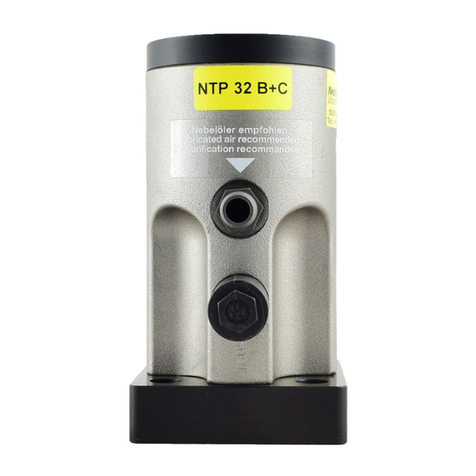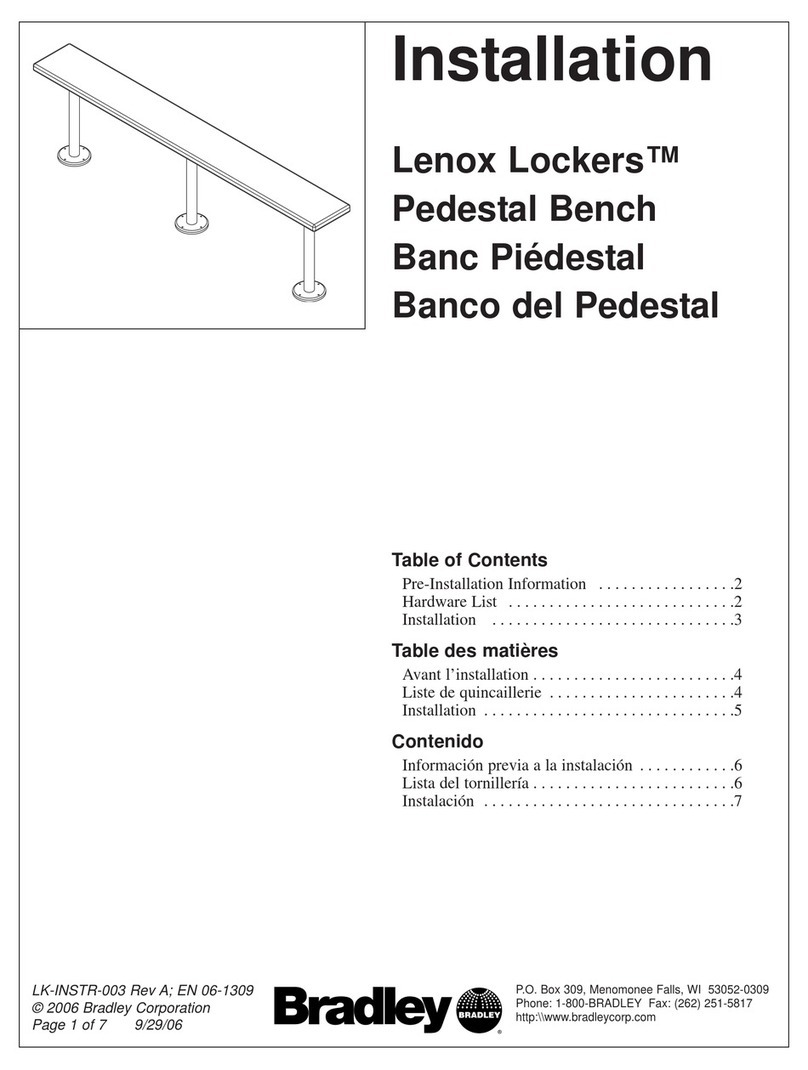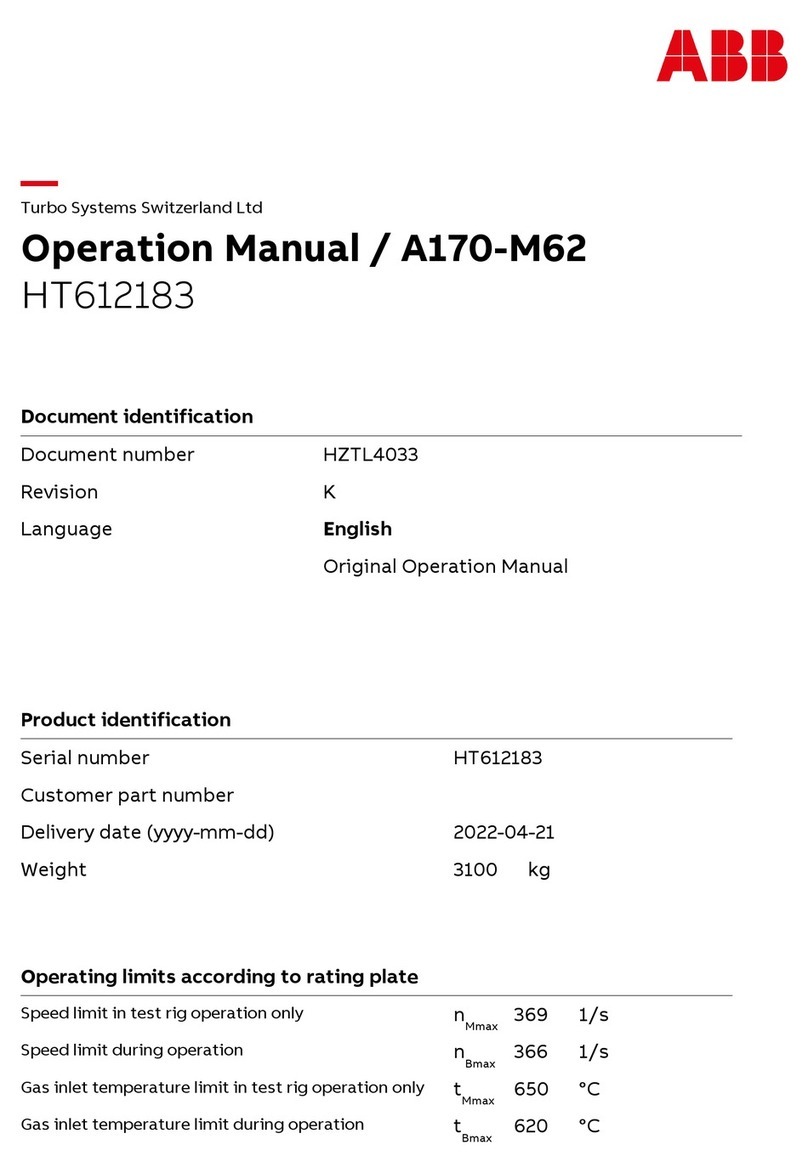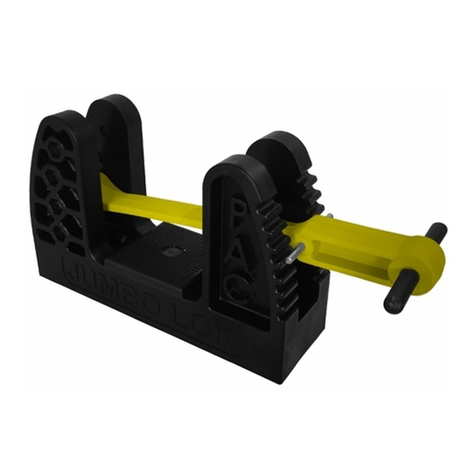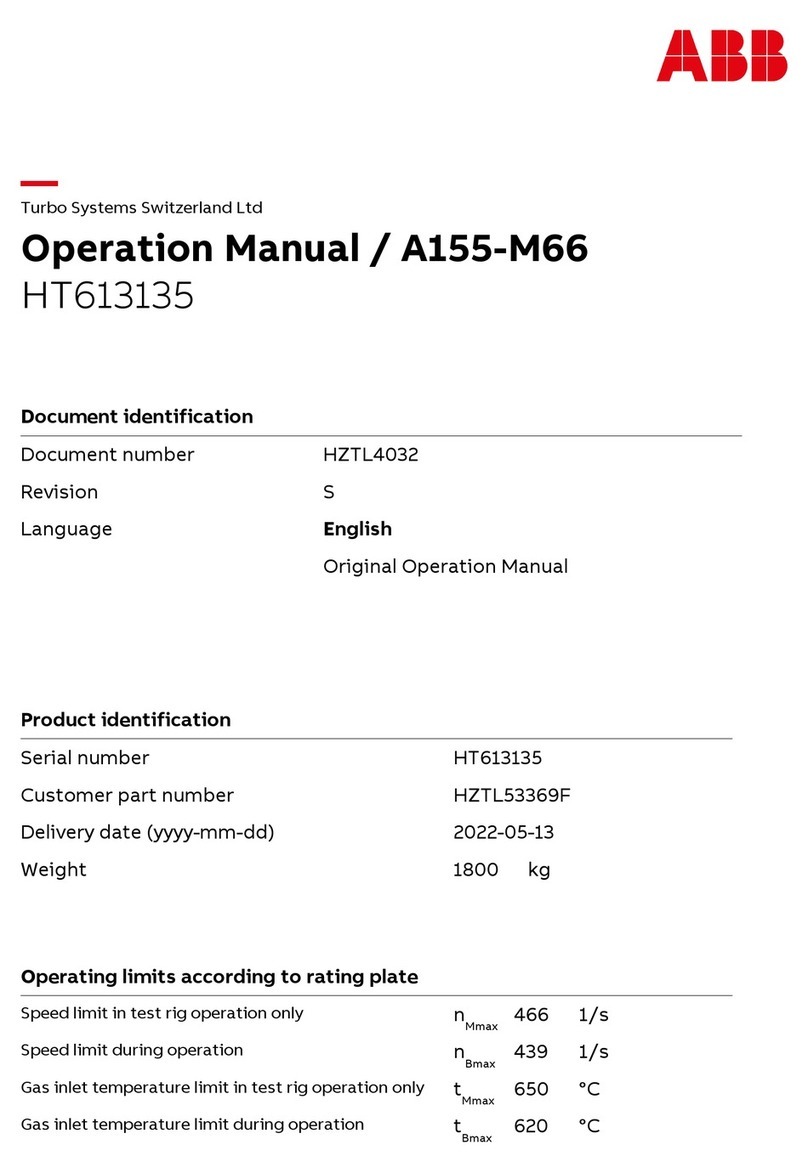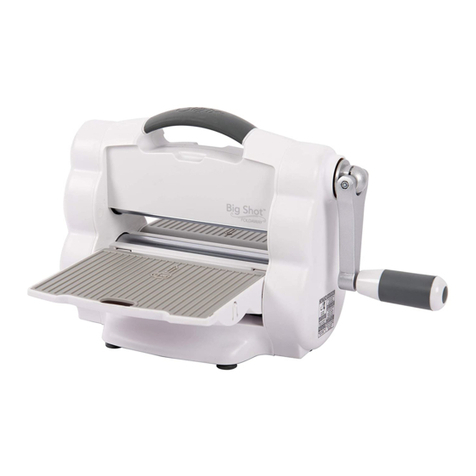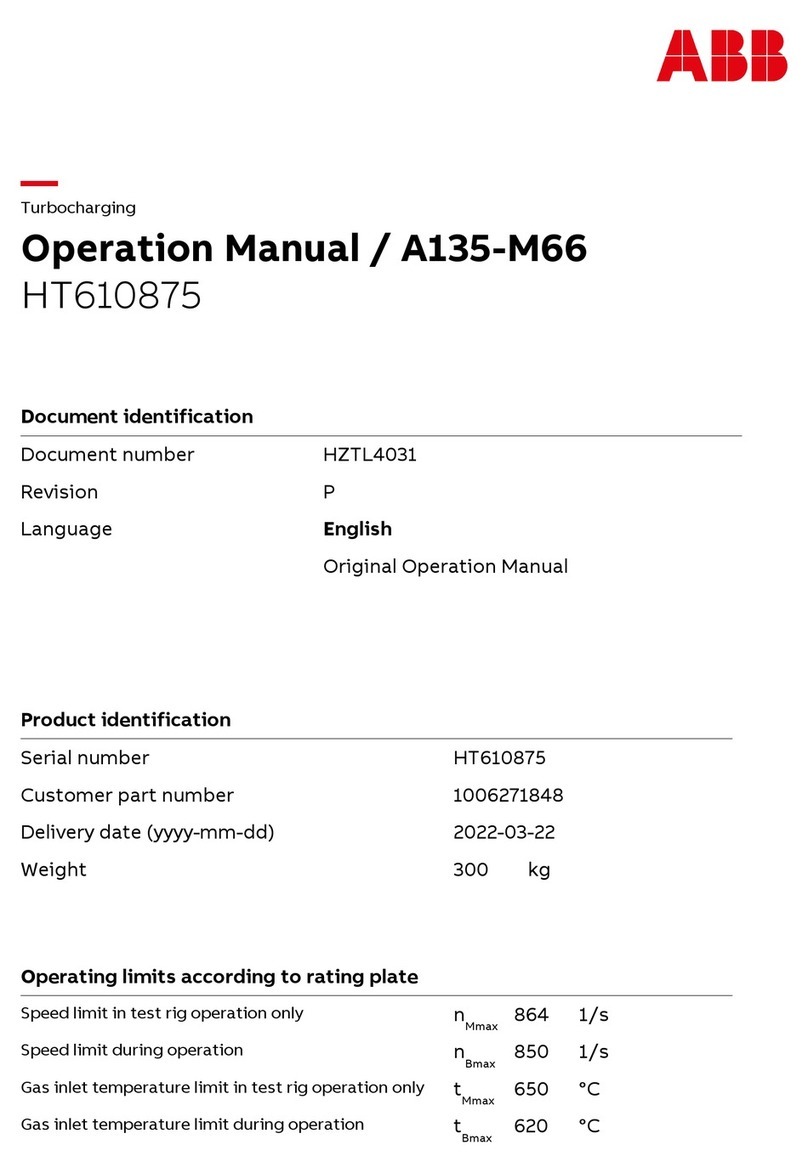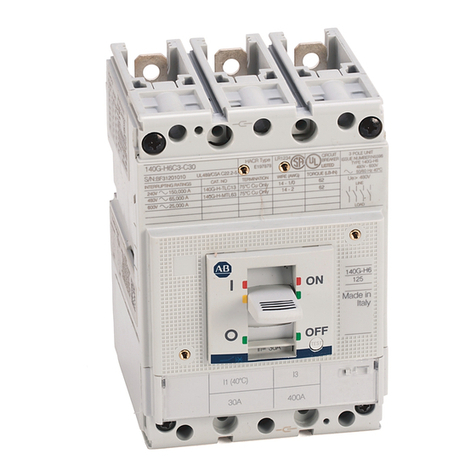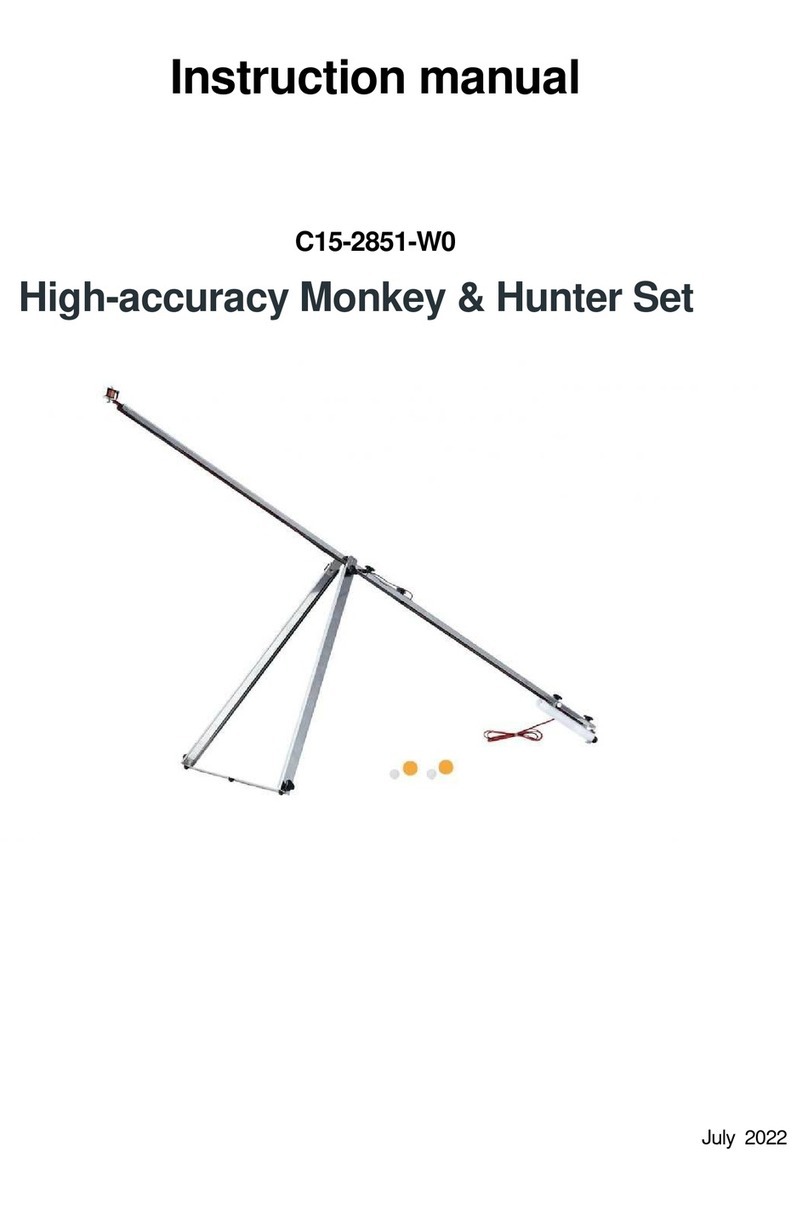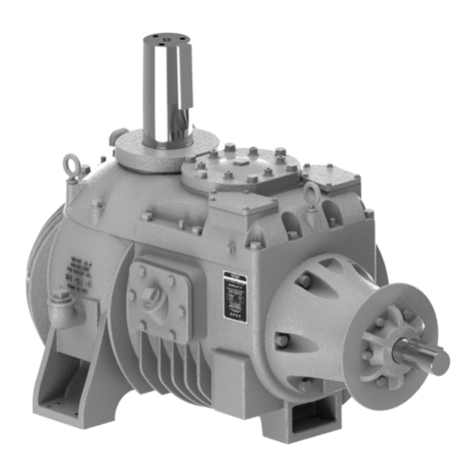Bornack LH200 User manual

Translation of the original instructions
EN
Directive 2006/42/EC on machinery
LH200

|
LH200
Load holder
INTENDED USE
The load holder LH may only be used
to manually lift, position or lower loads
from or to a higher or lower level. A suit-
able rope clamp can be used to facilitate
a better grip on the rope.
The load holder must be securely
attached to an adequately strong
anchor point. A hoist can be integrated
to move heavier loads.
Maximum useful load depending on the
ratio:
• : without a hoist kg
• : hoist kg
• : hoist kg
• : hoist kg
• : hoist kg
Minimum weight of the load: depending
on the ratio, see diagrams from page
Application temperature: - °C to
+°C
All other uses are deemed improper. The
company BORNACK will not be liable for
any ensuing damages. The user bears
the sole risk.
FUNCTION
Loads can be positioned in a controlled
manner with the LH. If the user lets
go of the pull rope, the auto-stop func-
tion blocks and prevents the load from
falling.
BRIEF DESCRIPTION
Subject to technical changes

EN
EQUIPMENT
• Load holder basic unit made of metal
and plastic.
• BORNACK kernmantle rope GEOSTATIC
mm or mm made of polyamide
with
- connector acc. to EN made of
aluminium or steel and
- sewn rope end connections with
thimbles
• DRYPACK
ACCESSORIES
• Accessories for mm kernmantle
rope:
- Rope clamp right
- Rope clamp left
- Pulleys for a ratio of : or :
- connectors acc. to EN
• Accessories for mm kernmantle
rope:
- Pulleys for a ratio of : or :
- connectors acc. to EN
• Collapsible bucket
USE
• Lifting, lowering and positioning of
loads
CAUTION: RISK TO LIFE!
It is not allowed to use the LH to
secure persons!
CONTENTS
Brief description
Product presentation
Possible misuses
Information before use
LH in use
Safety regulations
Other
EC Declaration of conformity
Test card
BRIEF DESCRIPTION

|
DRYPACK
Connector acc.
to EN
Pull rope
Strap for attaching
the hoist
Carrying handle
Basic unit with
identification
Thimble with
identification
Connector acc. to
EN, permanently
attached to the
basic unit
Supporting
rope
LH200
Pin
Cover over the
mechanical
part
Lock
washer

EN
Rope clamp
Simple pulley
for mm rope
Simple pulley
for mm
rope
Connector
acc. to EN
Double pulley
for mm rope
Double
pulley for
mm rope
Connection
opening
ACCESSORIES
Clamping
cam
Load hook
Connection
opening
Load hook

|
• Overloading can cause the LH to
fail and the transported load to fall!
Therefore, observe the minimum
useful weight of the LH.
• If the minimum weight is undercut,
this will restrict the lowering and posi-
tioning function. Therefore, observe
the minimum weight of the load.
• It is not allowed to use the LH to
secure persons.
• Incorrectly attached loads may fall and
endanger the operator. Therefore, use
suitable connectors to attach the load
to the support rope or the pulleys.
• Positioning the anchor point outside
the designated location can cause the
load to swing, and therefore endanger
the operator and other persons in the
vicinity. Therefore, always attach the
anchor point directly above the desig-
nated place.
• When selecting the anchor point,
ensure that it can bear a load of at
least kg.
• Icy or heavily soiled ropes can hinder
the blocking mechanism and cause
the load to fall. Therefore, look after
and clean the ropes; if necessary.
• When using the LH, there is a risk
of tripping on the unwound pull rope.
• Using this device without gloves can
lead to injuries of the hands. Therefore,
wear safety gloves when using this
device.
• Long, loose hair can become caught in
the moving part of the load holder.
Therefore, wear appropriate hair
protection and a helmet, or attach the
load securing device out of reach.
• The transported load can fall, if unsuit-
able lanyards are used (rope diameter,
rope expansion etc.). Only use original
ropes from BORNACK. Wear a safety
helmet.
• Rule out the risk of a fall load caused
by slack rope.
• Do not stand under suspended loads.
Operators must wear a safety helmet
and safety shoes.
• When working close to live parts,
select a suitable anchor point outside
the electrical hazard zone for the load
holder.
• The rope may jump out of the pulley, if
the pulley is not mounted or secured
correctly.
• When using pulleys, both plates of the
pulley always need to be secured by a
connector acc. to EN .
• When using double pulleys, the rope
needs to be inserted through both
rollers of the double pulley.
• A rope clamp must be used when
using the mm kernmantle rope.
• In case of strong winds, conduct a
hazard assessment to check whether it
can be used outdoors.
POSSIBLE MISUSES

EN
• The load may only be hooked into the
support rope or the pulleys to which
the support rope is connected.
• The lock function of the LH cannot
be guaranteed, if it is used over edges.
Therefore do not use the LH over
edges. When using the LH, ensure
that the support rope has not been
retracted too far because this may
cause the system to block and the load
can no longer be lowered.
• Any misuses not listed here can be
identified reliably by means of a sepa-
rate risk analysis by the user, and
appropriate safety measures can be
taken.
POSSIBLE MISUSES

|
Always check every time be-
fore use!
• The LH may no longer be used if
even very minor faults are discovered
when inspected.
• Faulty LHs may only be tested or
repaired by BORNACK or in a workshop
authorised in writing by BORNACK.
• Regular inspections are essential
because the safety of the user depends
on the eciency and durability of the
machine.
• The user must have completely read
and understood the instructions
before use.
VISUAL INSPECTION
• Check that the LH, in particular
rope, rope end connections, connector
and possible rolls of rope) is complete
and in a flawless condition.
• LH without mechanical or chem-
ical damage.
• No corrosion of metal parts.
• All rivets and screw connections are
complete and tightened.
• The last inspection by an expert was
carried out within the past months.
• The pins on the roller of the LH are
in a flawless condition, are tight and
complete in number.
FUNCTION TEST
• Moving components of the basic unit
runs smoothly.
• The snapper function of the connec-
tor(s) run smoothly. The snapper closes
and locks automatically.
• Arresting function responds to jerking
on the support rope and blocks the
rope.
• The device unlocks again when the
pull rope is pulled.
INFORMATION BEFORE USE

EN
PREPARATION
Before using the LH, calculate how
long the rope needs to be to reach the
required lifting height. The required rope
length is calculated as follows:
Rope length
= Lifting height + (ratio x lifting height)
In case of ratios of : (LH without a
hoist) e.g. at least m + ( x m) =
m rope is required for a lifting height
of m.
In case of ratios of : (LH with a :
hoist) e.g. at least m + ( x m) =
m rope is required for a lifting height
of m.
ATTENTION:
If possible, select an anchor point that is
directly above the load. The anchor point
must be able to bear at least kg.
CAUTION: RISK TO LIFE!
Select a work position for the operator
that ensures a clear line of vision to both
the load holder and the load. It is prohib-
ited to stand under suspended loads!
LH200 IN USE
Höhe = H
Übersetzung 1:1
Seillänge = 2 x H
Höhe = H
Übersetzung 2:1
Seillänge = 3 x H
Ratio 1:1
Rope length = 2 x H
Height = H
Ratio 2:1
Rope length = 3 x H
Height = H

|
LH200 IN USE
ATTENTION:
Select an anchor point that allows the
load holder to be used without it being
in the fall space of the load holder and
load!
A Attach the load holder basic unit
directly to the anchor point using the
connector acc. to EN . If necessary,
create an anchor point on a strong
building element using appropriate
anchor equipment (e.g. STEP sling).
B Lower the end of the load rope with a
connector acc. to EN or the pulley
with a connector down to the load
and attach.
AB

EN
APPLICATION OPTIONS
The LH is designed for a manual
tensile force of up to kg. As the load is
pulled with the LH manually using
physical force/body weight, the load
may not be too heavy. Otherwise, the
load cannot be lifted or lowered in a
controlled manner. Attach a hoist for
heavier loads (see page ).
C One/two rope clamp(s) (ascender
right/left) can be used for a better grip
on the mm rope and to facilitate use
of the LH. To do this, open the
clamping cam and insert the rope.
Observe the User Manual of the
rope clamp.
ATTENTION:
Wear safety gloves when using the
LH.
ATTENTION:
The rope must be free of knots and
kinks.
LH200 IN USE
C

|
LH200 IN USE
Lifting
D Pull the pull rope until the load is lifted
from the surface. Lift the load to the
required parking position.
Positioning
E Pull the load to the required position.
The auto-stop function of the LH
is activated by slowly releasing the
pull rope. The load can be parked in
this way.
Lowering
F The auto-stop function of the LH
is unlocked by pulling the pull rope.
The load can now be lowered in a
controlled manner. The lowering
process is blocked by the auto-stop
function, if the lowering speed is too
high.
1
2
F
E
D

EN
LH200 IN USE
ATTACHMENT OF THE HOIST
Observe the User Manual of the
pulleys.
ATTENTION:
To integrate the hoist, only the pulleys
sold as accessories for the LH may
be used.
ATTENTION:
The plates of the connection opening
must surround the rope and be secured
with a connector.
G To hook in the pulley, unscrew the
plates of the connection opening and
insert the rope. The rope must lie on
the roller on the connection opening
side. When inserting the rope, secure
the connection opening of the pulley
with a connector.
H When using double pulleys, ensure
that the ropes run parallel to one
another between the pulleys, and do
not cross.
H
G
G

|
LH200 IN USE
I A ratio of : is achieved as follows:
- . Place the support rope into the
lower pulley.
- . Attach the support rope with the
connector on the strap of the LH
to mount the hoist.
J A ratio of : is achieved as follows:
- . Place the support rope into the
lower pulley.
- . Place the support rope into the
upper pulley.
- . Attach the support rope with the
connector to the load hook of the
lower pulley.
1
2
3
J
1
2
I

EN
K A ratio of : is achieved as follows:
- . Place the support rope into the left
roller of the lower double pulley.
- nd Place the support rope into the
upper pulley.
- rd Place the support rope into the
right roller of the lower double pulley.
- th Attach the support rope with the
connector to the load hook of the
upper pulley.
LH200 IN USE
1
2
K
3
4
K

|
L A ratio of : is achieved as follows:
- . Place the support rope into the left
roller of the lower double pulley.
- . Place the support rope into the left
roller of the upper double pulley.
- . Place the support rope into the
right roller of the lower double pulley.
- . Place the support rope into the
right roller of the upper double pulley.
- . Attach the support rope with the
connector to the load hook of the
lower pulley.
COMBINATION
When combining this product with
other parts, there is a risk of mutual
impairment with respect to the function
and safety. Compatibility must be
assessed in a risk analysis. Only combine
with components that bear a CE symbol.
If you have any questions about compat-
ibility or you require help with the risk
analyses, feel free to contact BORNACK.
LH200 IN USE
1
3
2
L
4
5
L

EN
LH200 IN USE
MINIMUM WEIGHT
Depending on the ratio and work height,
the load requires a minimum weight to
guarantee the function of the LH.
To be able to lower the load when
operated from below, the load must,
e.g., have a minimum weight of approx.
kg, at a ratio of : and a lift height of
m.
0
5
10
15
20
25
30
35
010 20 30 40 50 60 70 80 90 100
Mindestlast (kg)
Arbeitshöhe (m)
Übersetzung 1:1
Ratio 1:1
Work height (m)
Minimum load (kg)

|
LH200 IN USE
0
5
10
15
20
25
30
35
010 20 30 40 50 60 70 80 90 100
Mindestlast (kg)
Arbeitshöhe (m)
Übersetzung 3:1
0
5
10
15
20
25
30
35
010 20 30 40 50 60 70 80 90 100
Mindestlast (kg)
Arbeitshöhe (m)
Übersetzung 2:1
Ratio 2:1
Work height (m)
Minimum load (kg)
Ratio 3:1
Work height (m)
Minimum load (kg)

EN
LH200 IN USE
0
5
10
15
20
25
30
35
010 20 30 40 50 60 70 80 90 100
Mindestlast (kg)
Arbeitshöhe (m)
Übersetzung 4:1
0
5
10
15
20
25
30
35
010 20 30 40 50 60 70 80 90 100
Mindestlast (kg)
Arbeitshöhe (m)
Übersetzung 5:1
Ratio 4:1
Work height (m)
Minimum load (kg)
Ratio 5:1
Work height (m)
Minimum load (kg)

|
SAFETY REGULATIONS
There is a risk to life if these safety
instructions are not observed!
• The LH may no longer be used
even in the case of very minor faults.
• Damaged, fall-stressed or dubious
equipment must be immediately with-
drawn and not used. Inspections may
only be carried out by BORNACK or an
expert briefed by BORNACK about the
inspection, including the corre-
sponding certificate. This must be
documented in the test card.
• Independent modifications or repairs
are not allowed.
• The LH may only be used by
trained sta that are familiar with the
material. They must be proficient in
handling the device and must have
been briefed about the possible risks
associated with its use.
• If it is no longer possible to position
the load in a controlled manner, the
device needs to be serviced by the
manufacturer.
• When operating the LH in areas
where there is a risk of falls, the oper-
ator must wear fall protection equip-
ment.
• Health impairments can jeopardise
the safety of the user when working at
heights or depths.
• Protect equipment during storing, use
and transportation against the eects
of heat (e.g. welding flames or sparks,
burning cigarettes) and chemicals (e.g.
acids, alkalis, oils) and mechanical
impact (e.g. sharp edges).
• The local safety guidelines (e.g. in
Germany, the DGUV Regulations
- and - issued by the
professional associations) and the
accident prevention guidelines for the
specific industry (UVV) must be
observed.
Table of contents
Popular Industrial Equipment manuals by other brands
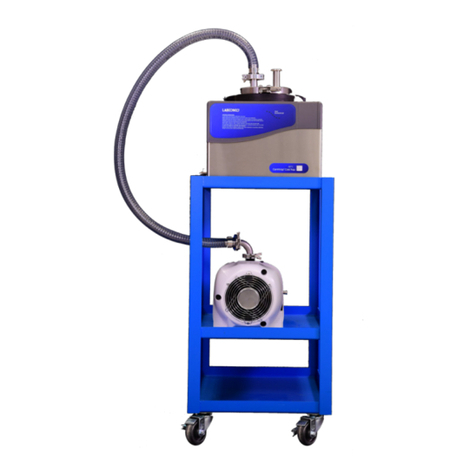
Cascade Sciences
Cascade Sciences MAXTRAP 50 Supplemental Installation & Operation Manual
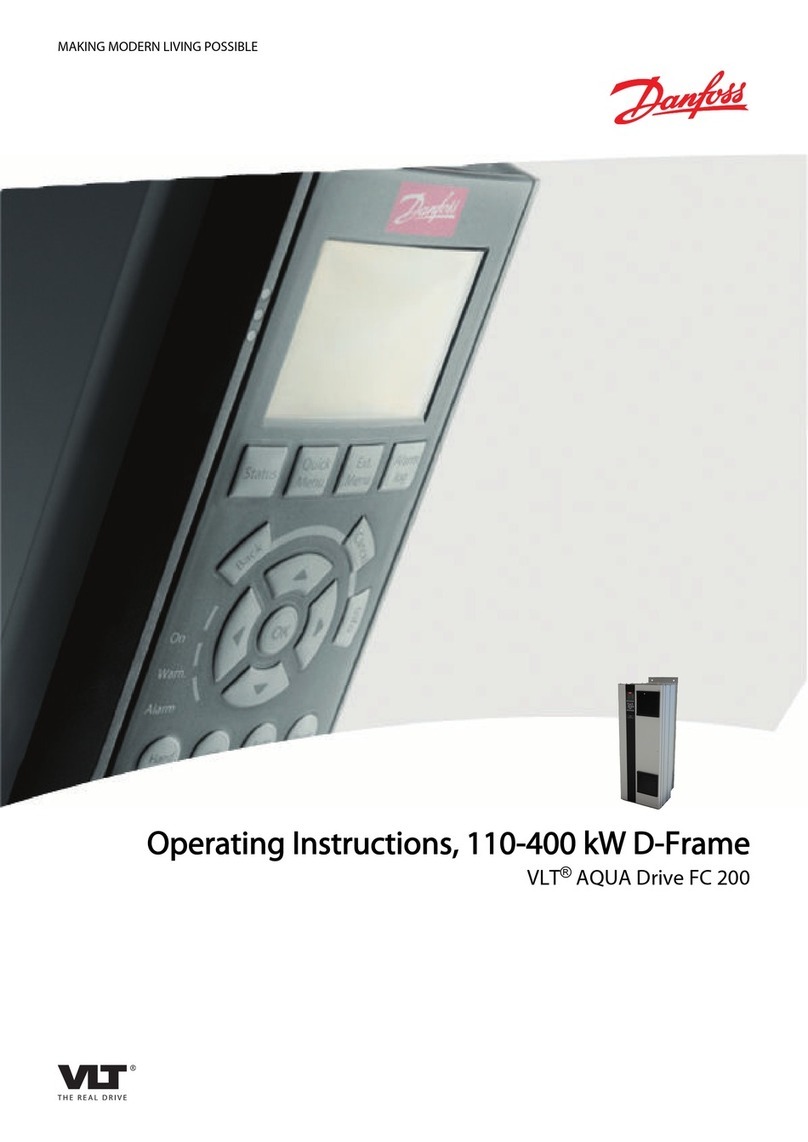
Danfoss
Danfoss VLT AQUA Drive D-Frame operating instructions

Deekax
Deekax DIVK-C121 DEMA Installation and user manual

FrontLine
FrontLine 10SS-NA Operation manual
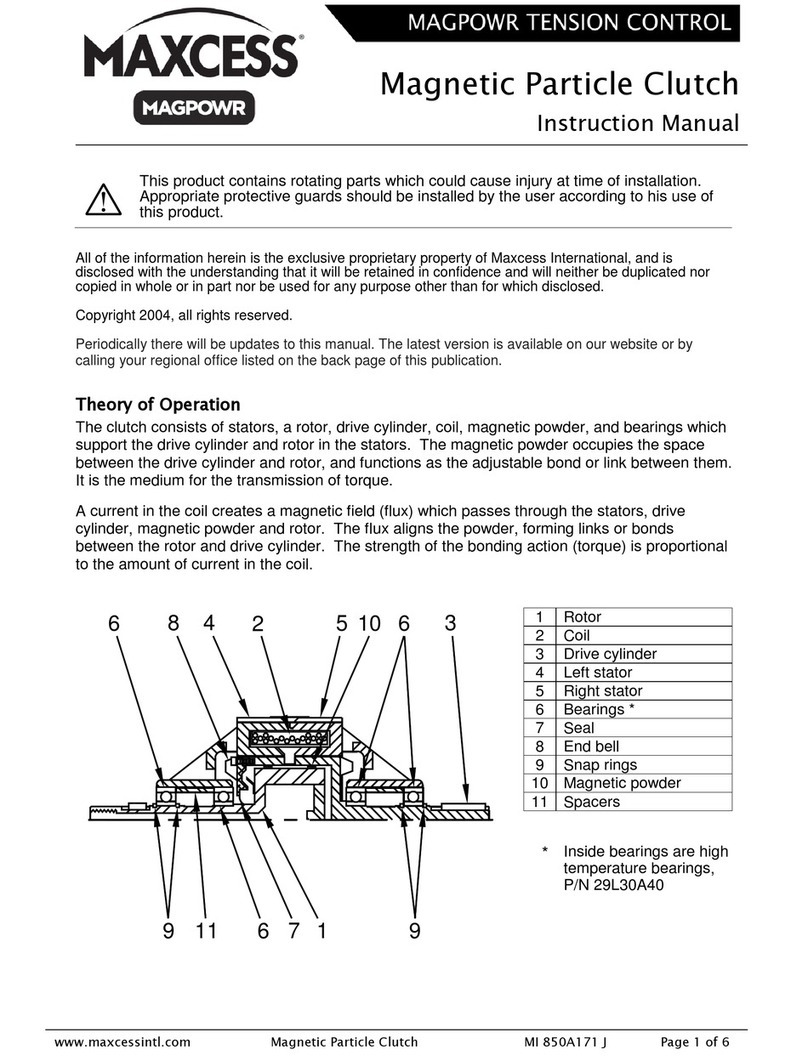
Maxcess
Maxcess MAGPOWR C1 instruction manual
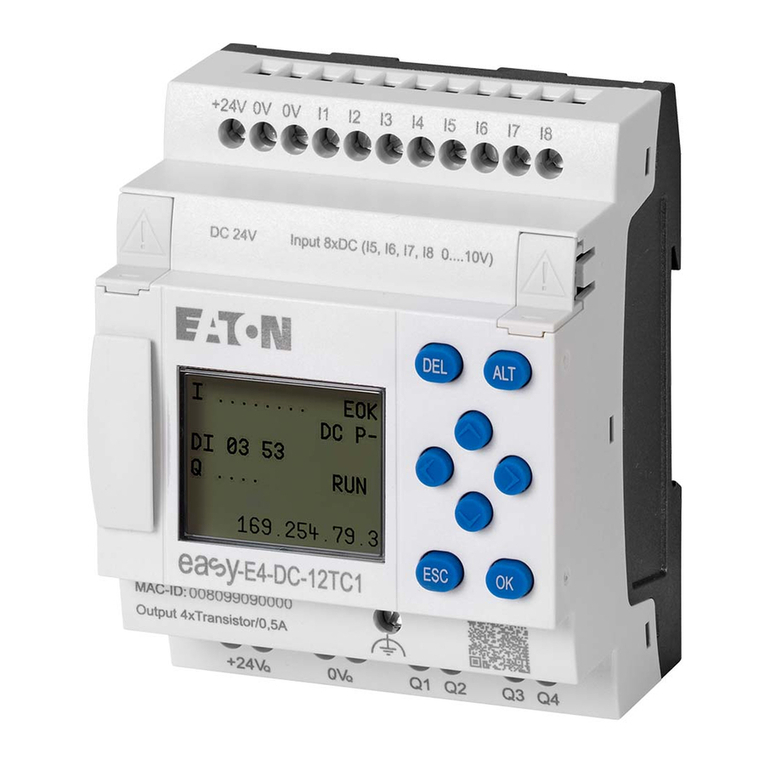
Eaton
Eaton easyE4 series Instruction leaflet
